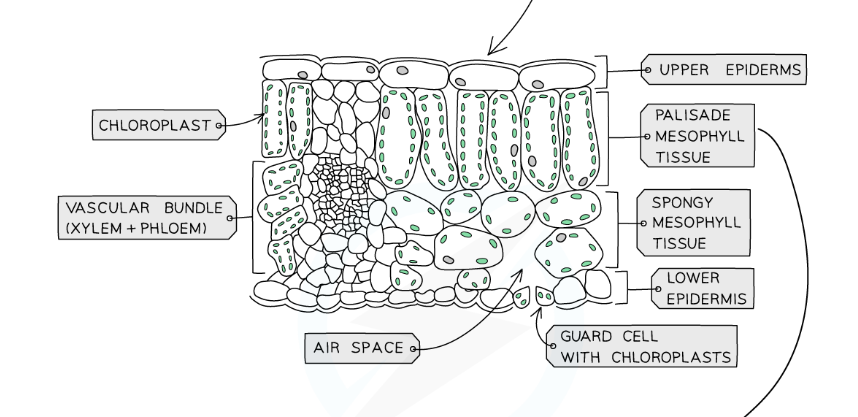photosynthesis
Word equation: Water + Carbon dioxide → Glucose + Oxygen
Balanced chemical equation: 6CO2 + 6H2O → C6H12O6 + 6O2
Photosynthesis occurs in leaves, more specifically in chloroplasts, within chloroplast there is chlorophyll, a pigment that absorbs blue and red light and reflects green light.
Photosynthesis is considered an endothermic reaction, ar it takes and uses energy from the environment.
Material gathering
Carbon dioxide: Gathered through diffusion across the stomata inside the leaf.
Water: Is gotten from the soil through the roots and principally through the xylem.
Light: Transformed into chemical energy in the bonds of glucose.
Glucose: Used for the different cellular processes like respiration.
Oxygen: Diffuses through the stomata to the outside, also used for aerobic respiration within the plant.
Factors affecting photosynthesis rates:
Amount of chlorophyll: The level of chlorophyll within an individual plant depends on:
Disease
Stress
Lack of nutrients
Limiting factors: Something present in a short supply thus, a hindrance to growth and life processes.
Light intensity
Carbon dioxide concentration
Temperature: Denature enzymes.
The amount of water needed is small compared to the transpired one, thus, water is hardly ever a limiting factor.
When the carbon dioxide, sunlight, and water are unlimited, in a warm environment the limit for photosynthesis is the plant’s own capacity to absorb and react to them.
gas exchange
6O2 + C6H12O6 → 6CO2 + 6H2O + ATP
Chloroplast is found in…
Palisade mesophyll cells.
Spongy mesophyll cells.
Guard cells (located around stomata)
The net gas exchange can be tested on an aquatic plant with the hydrogen carbonate indicator, which works due to the acidity of Carbon Dioxide in water, which shows the concentration of Carbon DIoxide.
Highest or higher → Yellow/Orange → More respiration than photosynthesis.
Atmospheric level → Red → Equal amounts of respiration and photosynthesis.
Lower or lowest → Magenta/Purple → More photosynthesis than respiration.
leaf structure

Pathway of Carbon Dioxide
Atmosphere → Air space in the spongy mesophyll →Palisade/spongy Mesophyll cells → Chloroplasts.
Structures
Wax cuticle: Avoid water evaporation with light.
Upper epidermis: Allows entrance of light.
Palisade mesophyll: Maximizes photosynthesis.
Spongy mesophyll: Provides surface area, required for diffusion.
Lower epidermis: Guard cells, absorb and lose water when opening or closing for gas flow, and Stomata, are in charge of gas exchange, and some water evaporation.
Vascular bundle: Xylem, which transports water, and Phloem, which transports mineral ions.
Adaptations for photosynthesis
Large leaf surface area: Allows diffusion and effective light absorption.
Thin: Quick diffusion.
Chlorophyll: Light absorption
Veins network: Transportation of water and glucose.
Stomata: Allows gas diffusion.
Thin and transparent epidermis: More light entrance and further absorption.
Wax cuticle: Protects from water evaporation and other harmful factors while allowing light to enter.
Palisade at the top: More light absorption and more chance that light does hit the chlorophyll within the chloroplasts.
Spongy mesophyll: Facilitates diffusion of Carbon Dioxide and increases the surface area.
Vascular bundles: They are thick to provide further support.
mineral requirements
Plants manufacture every nutrient they need.
The Minerals (inorganic substances) needed to produce nutrients and chlorophyll are actively absorbed by the root hair cells from the soil.
Effects of mineral ion deficiencies
Magnesium: Needed to produce chlorophyll
No green pigment, therefore the plants have yellowish leaves.
No proper photosynthesis is due to a lack of light absorption, thus growth is compromised.
With no proper growth, the plant is stunted in its growth.
Nitrates: Needed to produce amino acids.
Chlorophyll reduces too.
Yellowish leaves
No proper light absorption
 Knowt
Knowt
